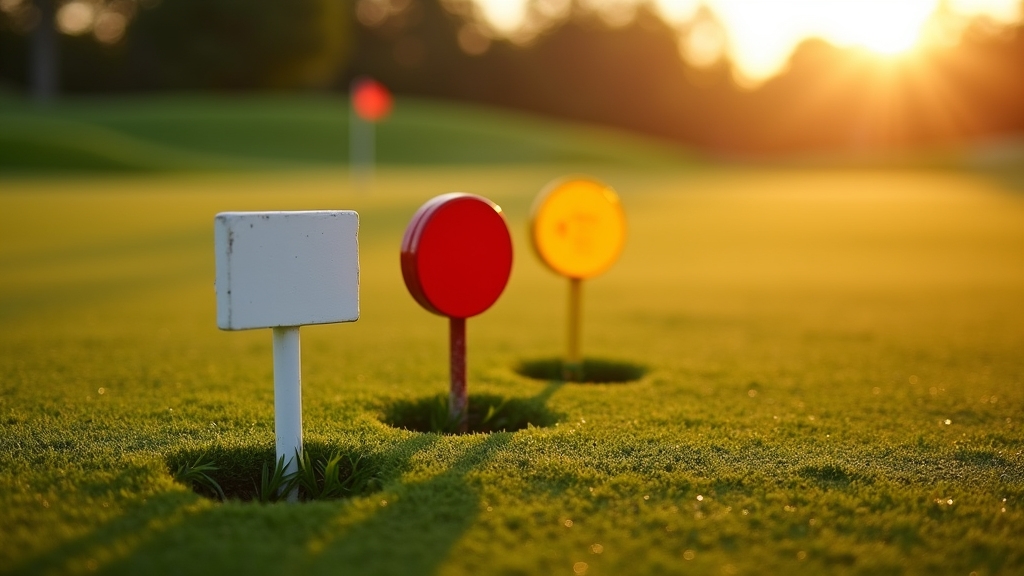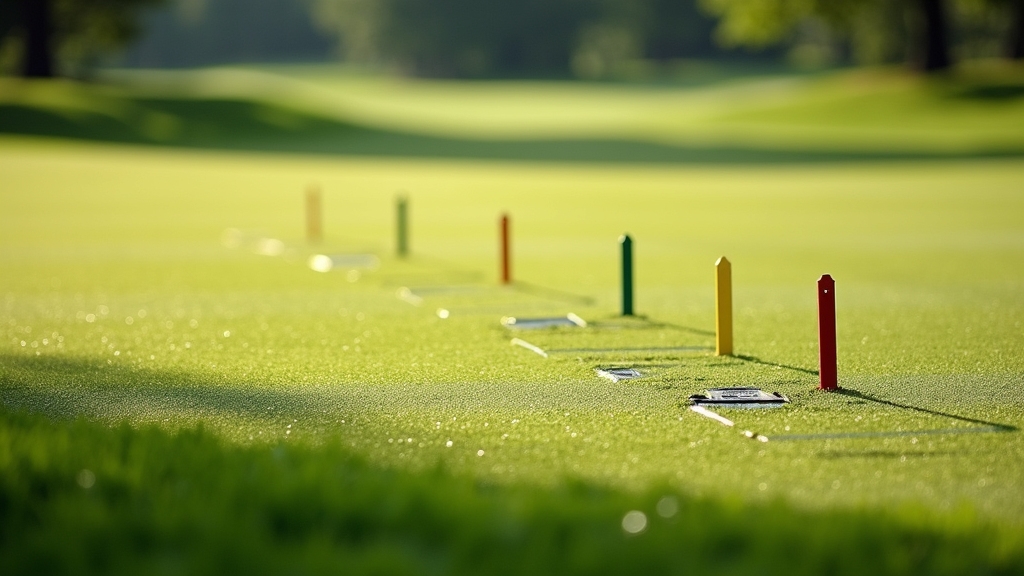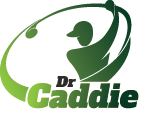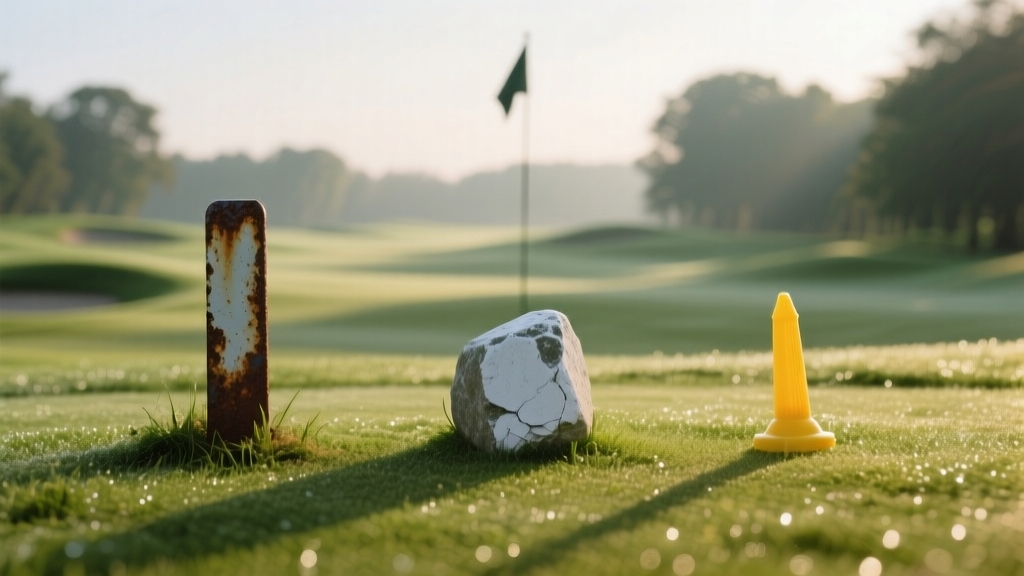Distance markers in golf help you gauge exact yardage to the green’s center, guiding your club selection and shot planning. You’ll find color-coded markers: red for 100 yards, white for 150, blue for 200, and yellow for 250, strategically placed on sprinkler heads or posts.
Proper placement guarantees fairness and pace of play, while tee markers define your start point. Technology like laser rangefinders enhances accuracy further. Understanding their standards and use lets you navigate any course with confidence and precision.
- Key Takeaways
- Types and Placement of Distance Markers
- Measurement Standards for Golf Distances
- Common Color Codes and Yardage Indications
- Role of Tee Markers in Course Setup
- Rules Governing Distance Markers
- Impact of Technology on Distance Markers
- Frequently Asked Questions
- Can Distance Markers Be Customized for Individual Golf Tournaments?
- How Often Are Distance Markers Recalibrated or Replaced on Courses?
- Do Distance Markers Differ Between Public and Private Golf Courses?
- Are There Environmental Concerns Related to Installing Distance Markers?
- How Do Beginners Best Use Distance Markers to Improve Their Game?
- Tee Markers: Setting the Stage for Your Perfect Shot
Key Takeaways
- Distance markers indicate yardage to the green’s center, commonly using color codes: red (100), white (150), blue (200), and yellow (250 yards).
- Markers are placed along the fairway in line with play, integrated into sprinkler heads or as posts, aiding club selection and shot planning.
- USGA rules require markers to measure straight-line distances, properly positioned before play, ensuring fairness and accurate course navigation.
- Electronic devices like laser rangefinders and GPS provide precise, real-time distance data, enhancing shot accuracy and strategic decision-making.
- Size and placement of markers must comply with standards to avoid course damage and maintain consistent, reliable distance measurement during play.
Types and Placement of Distance Markers
Although distance markers vary by course, you’ll most commonly find 100-yard, 150-yard, and 200-yard markers indicating the distance to the center of the green. These markers usually come color-coded: red for 100 yards, white for 150, and blue for 200—to help you quickly identify distances.
You’ll see them integrated into sprinkler heads or as free-standing posts centered along the fairway, aligning with the typical path of play. Proper maintenance, including drying grips using a hair dryer, ensures equipment remains reliable during play.
Keep in mind, all distances measure to the green’s center, not the pin, so you’ll need to adjust shots accordingly. Near the green, smaller stakes or blocks often guide cart placement but also serve as informal distance references.
These markers act as practical, visual aids, helping you select clubs and plan shots efficiently without relying on guesswork. Variations exist but most courses follow the standard color system.
Measurement Standards for Golf Distances
When measuring golf hole distances, the USGA requires you to use line-of-sight measurements from the tee to the center of the green. On dogleg holes, you measure along the fairway, including the pivot point, not in a direct straight line.
If no clear pivot exists, officials select a spot about 250 yards from the tee for men and 210 yards for women for consistent measurement. These distances represent the ball’s straight-line travel, excluding walking or driving length.
Yards are standard in the U.S. and U.K., while many countries use meters. Yardage marker posts at specific distances, such as 100, 150, or 200 yards from the green, help players gauge their shots and select clubs appropriately distance markers.
You’ll rely on this standardized approach for scorecards and course setup. Electronic distance measuring devices, like laser rangefinders and GPS, comply with USGA rules when used strictly for distance, ensuring accuracy and fairness.
Using the proper grip technique can also influence shot consistency and distance control on measured holes.
Common Color Codes and Yardage Indications

You know, those standard stake colors are super handy for quickly figuring out distances on the course. Typically, you’ll see red, white, blue, and yellow yardage markers that indicate specific ranges to the green. These colors indicate starting points for each hole based on skill level, age, or gender.
It’s pretty neat how understanding these color associations can help you gauge shot distances and pick the right club. Properly maintaining course features like distance markers alongside divot repair ensures a better playing experience for all golfers.
Just a heads up, though—some courses might mix up their color schemes a bit. So, it’s always a good idea to confirm the local standards before you tee off. Happy golfing!
Standard Stake Colors
A golf course uses a standardized color system for stakes to convey critical information about yardage, boundaries, and special conditions. You’ll quickly learn to recognize these color codes to navigate the course efficiently:
- Blue stakes mark ground under repair or waste bunkers and indicate mandatory relief zones. Selecting the correct stake color can also assist in choosing the appropriate grip size for better play.
- Green stakes and white stakes with green tops designate environmentally sensitive areas, often requiring special consideration.
- Brown, black, tan, or natural wood-colored stakes guide cart traffic and protect turf by defining paths and boundaries.
- White stakes clearly delineate out-of-bounds areas, where play is prohibited and penalty strokes apply.
Additionally, purple stakes are used to indicate areas of reclaimed water use on the course. Understanding these colors helps you respect course rules and maintain pace of play while protecting key areas.
Yardage Color Associations
How can you quickly gauge your distance to the green during a round? Yardage color associations on fairway markers provide a rapid visual reference. Red markers typically indicate 100 yards, white 150 yards, blue 200 yards, and yellow or gold 250 yards to the center of the green.
These colors aren’t fully standardized and may vary by course, so always confirm local norms. Understanding these codes allows you to select the right club and strategize shots efficiently. Yardage markers serve as a key tool for enhancing overall course management and shot planning.
For tee markers, black or gold tees denote the longest distances, blue tees suit mid to low handicaps, white tees for mid-level players, and red tees for beginners or juniors. Leveraging color-coded yardages refines shot accuracy and pace of play, essential for both casual rounds and competitive settings.
Choosing the appropriate golf ball, such as one with a matte finish or regular finish, can further influence your control and distance during play.
Role of Tee Markers in Course Setup
Because tee markers establish the starting points for each hole, their precise positioning and alignment directly influence course playability and fairness.
You must set tee markers 15-24 feet apart, perpendicular to the line of play, and directed toward the intended landing area. It is important to confirm which teeing grounds will be used with the Tournament Chairman to ensure proper setup. Proper weight distribution principles similar to those used in hauling golf carts can help maintain stability in marker placement.
On dogleg holes, align them toward the fairway, not the green, to guide proper shot direction. Place markers on flat, divot-free turf to maintain consistency and turf health. You also need to provide two club lengths of teeing surface behind markers for depth.
Key setup considerations include:
- Align markers square to the green center (par 3s) or landing zone (par 4s/5s).
- Rotate markers regularly to preserve turf.
- Use precise tools for accurate placement.
- Adjust marker location to control hole length and course rating.
Before players arrive, you should be the last committee member to evaluate the course to ensure all markers and hole locations are correctly placed.
Rules Governing Distance Markers

When you handle distance markers on the course, you must follow strict rules regarding their size, placement, and use to maintain fairness and accuracy. Wearing appropriate footwear can help prevent damage to the course when positioning markers.
Ball markers can’t exceed 1.5 inches in diameter. Alignment aids must stay under one inch tall and two inches wide. Oversized or decorative markers are prohibited. You must place markers precisely on the ball’s spot without affecting play.
It is the player’s responsibility to mark and replace the ball correctly to uphold proper golf etiquette. Distance devices are allowed but don’t replace physical markers. Tee markers defining the tee area must be properly positioned for consistent measurements.
| Marker Type | Size Limit |
|---|---|
| Ball Marker | Max 1.5 inches diameter |
| Alignment Aid | <1 inch height, <2 inch width |
| Tee Markers | Max 2 club-lengths apart |
| Distance Devices | Permitted, with restrictions |
| Relief Area Markers | Must stay within rules |
Impact of Technology on Distance Markers
Although traditional distance markers have long guided golfers, technological advancements have revolutionized how you measure and interpret distances on the course. GPS devices offer precise, real-time yardage to hazards and pins, improving your club selection.
Laser rangefinders provide exact line-of-sight measurements, speeding up decisions and enhancing accuracy. Smart tracking systems analyze ball flight and launch data, refining your distance control. These tools also provide real-time feedback during practice to enhance swing mechanics and training efficiency.
The use of advanced radar and camera technology in these systems ensures highly accurate shot data for better performance analysis. GPS and laser rangefinders deliver real-time, precise distances, while smart tracking fine-tunes your shot accuracy and club choice.
At practice facilities, digital range technologies deliver tailored yardages, bridging practice and play. Key impacts include:
- Instant, precise distance data via GPS watches.
- Accurate target measurements from laser rangefinders.
- Advanced analytics integrating shot metrics with distance.
- Enhanced practice relevance through digital range markers.
Frequently Asked Questions
Can Distance Markers Be Customized for Individual Golf Tournaments?
Yes, you can customize distance markers for individual golf tournaments, provided you adhere to size and placement regulations. You’ll want to guarantee markers stay within set dimensions to avoid penalties and don’t interfere with play.
Custom logos, branding, and personalized designs are common and enhance player experience. Just focus on durability, visibility, and compliance to maintain fairness and professionalism while reinforcing your tournament’s identity effectively.
How Often Are Distance Markers Recalibrated or Replaced on Courses?
You’ll find distance markers recalibrated annually, like clockwork, during course rating reviews to keep measurements sharp and precise. Replacement happens every 3 to 5 years, depending on wear from weather and traffic.
If the markers fade, crack, or shift due to ground changes, they’re updated sooner. High-end courses might stretch this interval using durable materials, but you’ll always want regular checks to guarantee accuracy and fair play on every hole.
Do Distance Markers Differ Between Public and Private Golf Courses?
Yes, distance markers differ between public and private golf courses. On private courses, you’ll often find custom or premium markers like colored stakes, rubberized plates, or unique natural references, tailored to the course’s style.
In contrast, public courses usually use standardized, durable stakes or visible markers for easy replacement. Public courses also rely more on distance boards or tee signs, while private courses have greater flexibility in marker design and placement.
Are There Environmental Concerns Related to Installing Distance Markers?
Yes, installing distance markers can pose environmental concerns. You’ll likely disrupt turf and soil, harming root systems and microhabitats during installation. You might also increase chemical use for maintenance, risking runoff contamination and water pollution.
Choosing sustainable materials and careful site selection helps mitigate these impacts. To minimize harm, you should avoid sensitive areas, limit irrigation, and collaborate with environmental experts for compliant, eco-friendly placement and upkeep practices.
How Do Beginners Best Use Distance Markers to Improve Their Game?
You best use distance markers by practicing shots from 100-, 150-, and 200-yard markers to calibrate your club selection. Track your average carry distances with each club, adjusting choices as needed. Use markers to plan approach shots, targeting safe zones while avoiding hazards.
Incorporate marker data into practice routines to refine distance control and accuracy. This consistent feedback helps you internalize yardages, improving shot precision and course management skills efficiently.
Tee Markers: Setting the Stage for Your Perfect Shot
Understanding distance markers is essential for improving your game and steering the course efficiently. By recognizing types, placements, and color codes, you can make smarter club selections and strategy decisions. Don’t overlook the role of tee markers or the rules that keep everything fair.
With advancing technology, distance markers are more precise than ever. So, why gamble with guesswork when accurate information is right in front of you? Use these tools to play smarter and score better.

